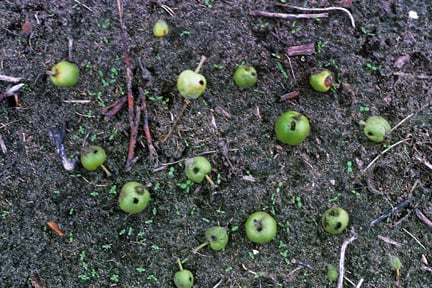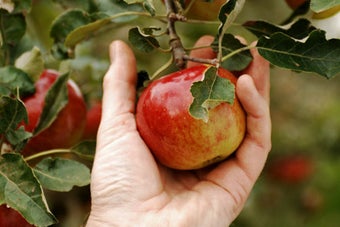
Quick facts
Common name - June drop
Scientific name - None
Plants affected - Apples
Main causes - Adverse weather, excessive fruit load, cultivation methods
Timing - Early summer
What is June drop?
After apple trees flower, there is a period of fruit shedding. Although it appears dramatic, there is little that can be done to prevent the loss of fruit. Thankfully this is not as serious as it might appear. Although many fruits fall, sufficient usually remain attached and go on to develop into mature fruits.
Apples are large fruits and just 1 in 20 flowers setting fruit can constitute a full crop (or as many as the tree can support). In contrast, the loss of smaller fruits, such as cherries, is highly significant as more of the fruits must set to constitute a full crop (or as much as the tree can support until harvest).
Symptoms
Numerous fruitlets (ten-pence-sized fruits) are shed and fall to the ground. The peak is about eight weeks after flowering in early July, although fruit loss can often continue until mid-July. Earlier fruitlet losses are usually due to poor pollination or unfavourable weather after flowering.
can be quite prolonged and it is unwise to commence thinning fruits until the fall is complete, just in case too many fruits are removed. Once the extent of natural apple losses are known, decisions can be made.
Control
There are no preventative measures except to practise good cultivation.
If the is severe every year and affects yields, the cultivation regime of the tree should be reviewed. Pruning to allow more light into the tree is one that gardeners can try.
A lack of nitrogen is thought to be sometimes involved so attention should be paid to applying a general fertiliser such as Growmore each spring. However, be careful not to over-fertilise as excessive nitrogen can itself lead to fruit losses.
Insufficient soil moisture may contribute to fruit fall. Watering, followed by , in dry spring weather may help.
Cause
There are three main factors associated with the :
- Natural loss of surplus fruits is part of the cause – trees can only carry so many fruits
- Competition for the limited carbohydrate resources (energy) – the period before the leaves are fully expanded and contributing carbohydrates has been identified as significant. If the tree runs short of carbohydrates, fruits are more likely to be shed. This is more likely to occur in poor weather when (the source of carbohydrates in trees) is inhibited by cool daytime temperatures and cloudy skies. Warm nights may also cause fruit losses as increased in the period of darkness will consume carbohydrates
- Young trees often suffer especially. Severe fruit drop is probably due to competition for carbohydrates from the shoots and roots. As the trees grow the problem becomes less severe


